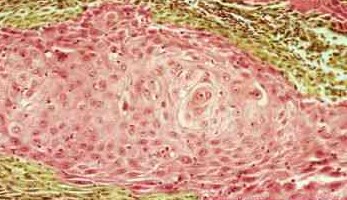BMC Cancer:基因诊断评估口腔鳞状细胞癌复发风险
2011-10-18 MedSci原创 MedSci原创
口腔鳞状细胞癌光镜照相(图) 口腔鳞状细胞癌发病率在所有颈部和头部癌症患者总人数中大约占有1/4的比例。它是癌症引起死亡的主要因素—主要是由于目前没有有效的组织检查方法预测癌症是否会复发。 在最新一期的《BMC Cancer》杂志上,科学家们发现有四种基因的表达可以准确的预测患者复发口腔鳞状细胞癌的风险。[A gene signature in&

口腔鳞状细胞癌光镜照相(图)
口腔鳞状细胞癌发病率在所有颈部和头部癌症患者总人数中大约占有1/4的比例。它是癌症引起死亡的主要因素—主要是由于目前没有有效的组织检查方法预测癌症是否会复发。
在最新一期的《BMC Cancer》杂志上,科学家们发现有四种基因的表达可以准确的预测患者复发口腔鳞状细胞癌的风险。[A gene signature in histologically normal surgical margins is predictive of oral carcinoma recurrence.BMC Cancer.11. October 2011]
来自加拿大安大略湖癌症中心的,由Suzanne Kamel-Reid博士和Igor Jurisica博士负责的研究小组收集了多伦多综合医院的多例口腔鳞状细胞癌和非口腔鳞状细胞癌患者的口腔组织样本,并进行了检测。
研究者们使用了meta分析的统计方法,综合了之前研究报道的五项基因芯片研究结果,并结合自己的研究结果,准确的找除了在口腔鳞状细胞癌组织中高表达的138种基因。并发现其中有四种基因与口腔鳞状细胞癌的复发率密切相关,它们分别是MMP1, COL4A1, P4HA2和THBS2。
研究者们说道:“我们的数据显示高表达MMP1, COL4A1, P4HA2和THBS2与高的口腔鳞状细胞癌复发率相关。这项研究将有助于未来临床口腔鳞状细胞癌的复发诊断。”(生物谷 Bioon.com)
A gene signature in histologically normal surgical margins is predictive of oral carcinoma recurrence
Patricia P Reis , Levi Waldron , Bayardo Perez-Ordonez , Melania Pintilie , Natalie Naranjo Galloni , Yali Xuan , Nilva K Cervigne , Giles C Warner , Antti A Makitie , Colleen Simpson , David Goldstein , Dale Brown , Ralph Gilbert , Patrick Gullane , Jonathan Irish , Igor Jurisica and Suzanne Kamel-Reid
Background
Oral Squamous Cell Carcinoma (OSCC) is a major cause of cancer death worldwide, which is mainly due to recurrence leading to treatment failure and patient death. Histological status of surgical margins is a currently available assessment for recurrence risk in OSCC; however histological status does not predict recurrence, even in patients with histologically negative margins. Therefore, molecular analysis of histologically normal resection margins and the corresponding OSCC may aid in identifying a gene signature predictive of recurrence.
Methods
We used a meta-analysis of 199 samples (OSCCs and normal oral tissues) from five public microarray datasets, in addition to our microarray analysis of 96 OSCCs and histologically normal margins from 24 patients, to train a gene signature for recurrence. Validation was performed by quantitative real-time PCR using 136 samples from an independent cohort of 30 patients.
Results
We identified 138 significantly over-expressed genes (>2-fold, false discovery rate of 0.01) in OSCC. By penalized likelihood Cox regression, we identified a 4-gene signature with prognostic value for recurrence in our training set. This signature comprised the invasion-related genes MMP1, COL4A1, P4HA2, and THBS2. Over-expression of this 4-gene signature in histologically normal margins was associated with recurrence in our training cohort (p=0.0003, logrank test) and in our independent validation cohort (p=0.04, HR=6.8, logrank test).
Conclusion
Gene expression alterations occur in histologically normal margins in OSCC. Over-expression of the 4-gene signature in histologically normal surgical margins was validated and highly predictive of recurrence in an independent patient cohort. Our findings may be applied to develop a molecular test, which would be clinically useful to help predict which patients are at a higher risk of local recurrence.
本网站所有内容来源注明为“梅斯医学”或“MedSci原创”的文字、图片和音视频资料,版权均属于梅斯医学所有。非经授权,任何媒体、网站或个人不得转载,授权转载时须注明来源为“梅斯医学”。其它来源的文章系转载文章,或“梅斯号”自媒体发布的文章,仅系出于传递更多信息之目的,本站仅负责审核内容合规,其内容不代表本站立场,本站不负责内容的准确性和版权。如果存在侵权、或不希望被转载的媒体或个人可与我们联系,我们将立即进行删除处理。
在此留言








#BMC#
68
#细胞癌#
64
#复发风险#
76
#口腔鳞状细胞癌#
62
#基因诊断#
63